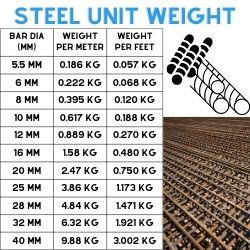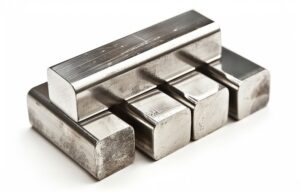Steel Weight Formula: How to Calculate Weight of Steel Bars, Beams & Shapes
Steel Weight Formula: Full Guide to Weight Calculation
Understanding the weight of steel is essential across industries like construction, fabrication, piping, and manufacturing. Whether you’re estimating the load-bearing capacity of a beam or calculating transport costs, having a solid grasp of steel weight formulas helps in making informed decisions.
This guide covers:
- Common weight formulas for steel
- Unit weight tables for standard sizes
- Real-world applications in steel structures, pipes, and bars
- Frequently asked questions
- Key internal references for quality materials
The Weight Formula for Steel
The basic steel weight formula is:
Weight (kg) = Volume (m³) × Density (kg/m³)
To simplify this for day-to-day usage, steel manufacturers and engineers often use a direct formula based on shape and unit length:
Weight (kg/m) = (D² × 0.006162) for Round Bars
Weight (kg/m) = Width × Thickness × 7.85 for Plates/Sheets
Here,
- D is diameter in mm
- 7.85 is the density of steel in g/cm³ (or 7850 kg/m³)
The Weight of Steel Bars and Shapes
1. Round Bars
Used widely in construction and machining:
| Diameter (mm) | Weight per meter (kg) | Weight per foot (kg) |
|---|---|---|
| 6 mm | 0.222 kg | 0.067 kg |
| 8 mm | 0.395 kg | 0.120 kg |
| 10 mm | 0.617 kg | 0.188 kg |
| 12 mm | 0.89 kg | 0.270 kg |
| 16 mm | 1.58 kg | 0.480 kg |
| 20 mm | 2.47 kg | 0.751 kg |
| 25 mm | 3.86 kg | 1.174 kg |
| 32 mm | 6.32 kg | 1.925 kg |
These bars are also used in applications involving Stainless Steel Flanges and Stainless Steel 304L Flanges, offering strong joint connections in pipeline systems.
The Weight of Steel Beams and Structures
Steel beams come in multiple profiles like I-beams, H-beams, and channels. Their weights are calculated using profile geometry and steel density.
Formula:
Weight = Cross-Sectional Area × Length × Density
For standard profiles, weight per meter can be directly taken from ISMC (Indian Standard Medium Channel) weight charts.
For example:
- ISMC 75 = ~7.1 kg/m
- ISMC 150 = ~17.1 kg/m
- ISMC 125 = ~13.1 kg/m
These profiles are commonly used alongside Stainless Steel Tube Manufacturer Products in heavy fabrication and frame structures.
Overview of Common Steel Types and Their Density
| Steel Type | Density (kg/m³) |
|---|---|
| Carbon Steel | 7850 |
| Stainless Steel 304 | 8000 |
| Stainless Steel 316 | 8000 |
| Mild Steel (MS) | 7850 |
| Tool Steel | 7700–8000 |
| Duplex Steel | 7810 |
Each variant is used for specific applications:
- SS 304/316 – corrosion resistance in chemical industries
- Mild Steel – structural and general fabrication
- Tool Steel – high hardness requirements
Unit Weight of Steel: Size-wise Table
| Size | Weight (kg/m) | Weight (kg/ft) |
|---|---|---|
| 6 mm | 0.222 kg | 0.067 kg |
| 8 mm | 0.395 kg | 0.120 kg |
| 10 mm | 0.617 kg | 0.188 kg |
| 12 mm | 0.89 kg | 0.270 kg |
| 16 mm | 1.58 kg | 0.480 kg |
| 20 mm | 2.47 kg | 0.751 kg |
| 25 mm | 3.86 kg | 1.174 kg |
| 32 mm | 6.32 kg | 1.925 kg |
This information is helpful for industries that require precision in estimating weight for transport, design, and procurement of components such as Stainless Steel Heat Exchanger Tubes.
Conclusion: Why Steel Weight Calculation Matters
Whether you are dealing with reinforcement bars, beams, flanges, or tubes, knowing how to calculate the weight of steel is a foundational requirement. It ensures:
- Efficient design
- Accurate cost estimations
- Compliance with structural safety standards
Industries rely on this knowledge to handle everything from fabrication to final installation, especially when sourcing from a reputed Stainless Steel Tube Manufacturer or Stainless Steel Flanges Supplier.
FAQs: Steel Weight Calculation
Q1. What is the unit weight of mild steel?
Mild steel has a density of approximately 7850 kg/m³. You can use this with volume to calculate total weight.
Q2. What is the formula to calculate round bar weight?
Use: Weight (kg/m) = (D² × 0.006162), where D is diameter in mm.
Q3. How is the weight of a steel plate calculated?
Weight = Width × Thickness × Length × 7.85
Q4. How accurate are theoretical steel weight formulas?
They are highly accurate for standard shapes and densities, but fabrication processes may introduce slight variations.
Q5. Why is knowing steel weight important?
It helps in budgeting, transport planning, design calculations, and load management.
Q6. Is there a difference between MS and SS steel weight calculations?
Yes, slightly. While the formula remains the same, the density of stainless steel (≈8.0 g/cm³) is a bit higher than mild steel (7.85 g/cm³), affecting the final weight.


